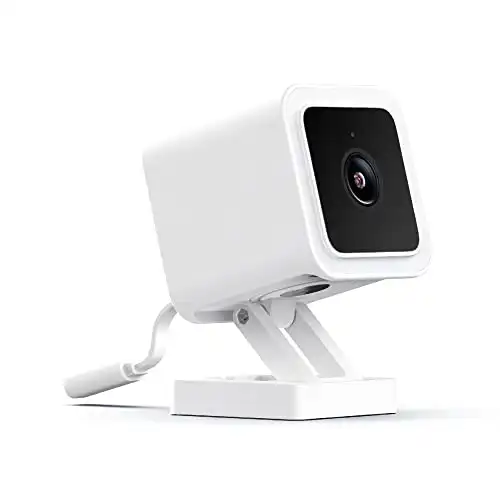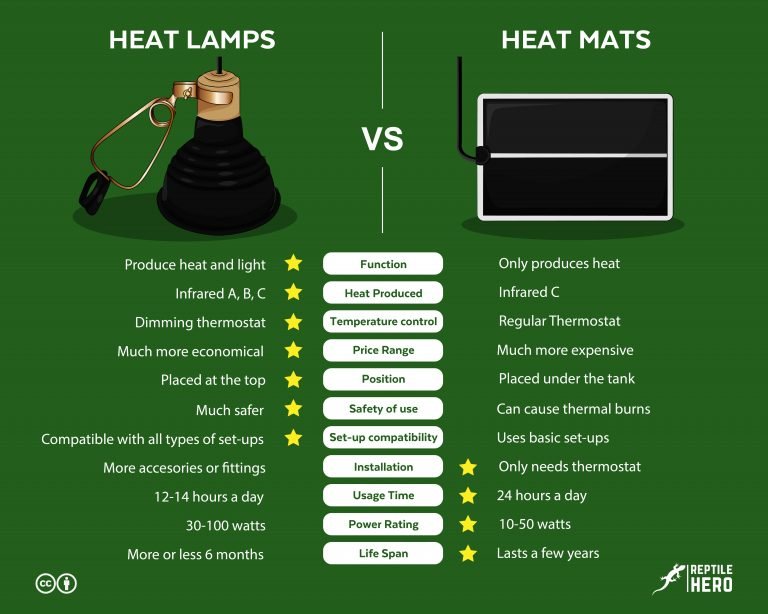Choose the Perfect Camera For Your Gecko Tank
Reptile researchers and pet owners have come a long way when it comes to observing geckos from a distance. Now, even pet parents who aren’t tech-savvy can keep a close eye on their geckos with a simple little security camera!
Generally, there are 10 factors that determine whether a camera is compatible with a specific gecko’s tank:
- Dimensions
- Power source
- Night vision capability
- Functionality
- Connectivity
- Media storage
- Field of view
- Picture quality
- Waterproof rating
- Resistance to heat
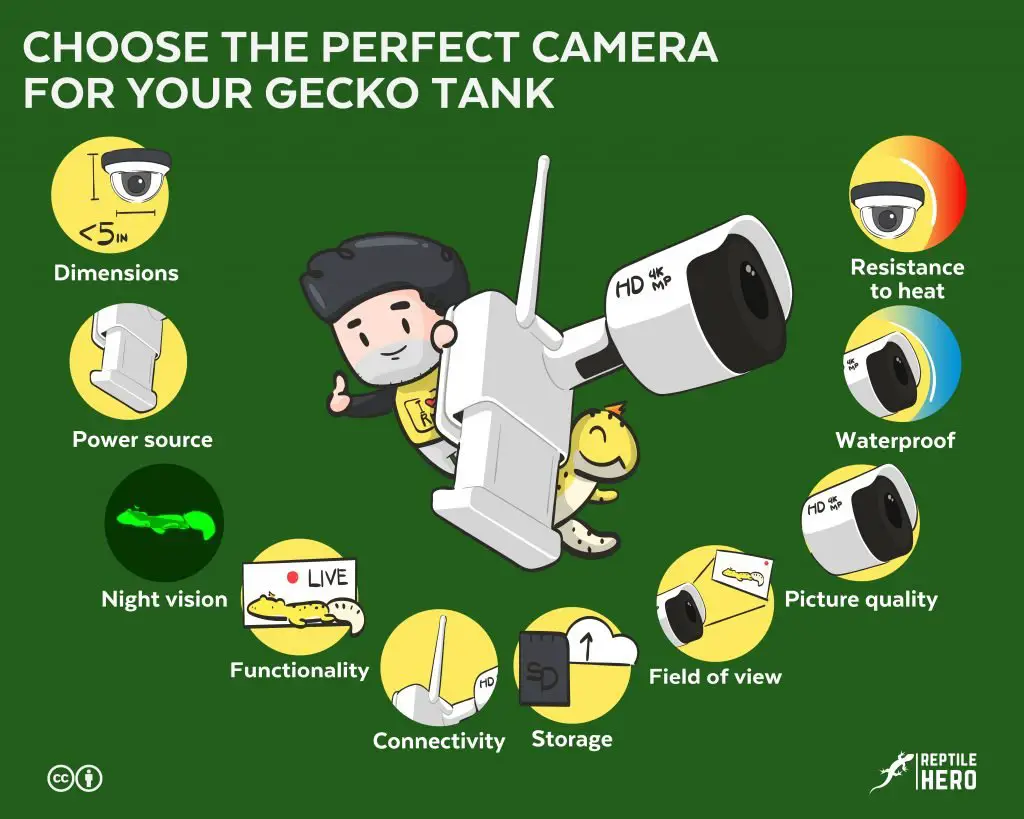
If normal red lights can disturb the day-night cycle of most geckos whenever it is used for night-viewing, then will the red indicator lights of cameras negatively affect your pets too? Contrary to popular belief, the answer is NO—read on to find out how this is possible!
If you are in a hurry we selected already the best camera for you. It took us a while but here it is the Wyze from Amazon.
10 Factors to Consider When Choosing a Camera for Gecko Tanks
As of writing this article, I can tell that there are no cameras specifically made to be placed inside gecko tanks. Instead, we, reptile owners, have used a variety of other cameras to monitor our geckos and other exotic pets. People have used webcams, pet cams, trail cams, action cams, and even CCTV cams.
In this guide, I will be specifically discussing security camera features that will serve practical use for gecko keepers and breeders. However, this may also apply to other camera types.
#1—Dimensions
Overall, modern security cameras measure up to no more than 10 in (25.4 cm) in length, width, and height. However, if intended to be placed inside a gecko tank, compact cameras—under 5 in (12.7 cm)—are recommended so less usable space is lost.
The first thing I thought of when I started searching for a camera for my gecko’s tank is the size. I didn’t want a bulky camera that stuck out like a sore thumb in my leopard gecko’s enclosure—especially since I want to make it look as naturalistic as possible.
Neither did I want a tall but slim security camera because I know that my curious little leo could easily scale and potentially that knock over.
Of course, there are unobtrusive pinhole and mini spy cameras available as well. These are the size of a dime or even smaller. However, if these tiny cameras get detached from where I had mounted them, my pet will be at risk of choking or suffering from really bad impaction.
Big models are a viable option, but I would have to install them outside the vivarium so that I would not have to sacrifice a substantial amount of otherwise usable space for my leo.
Golden rule: Cameras for gecko tanks should be small enough to be of minimal disturbance but also be big enough that they can’t be ingested by geckos—even if accidentally.
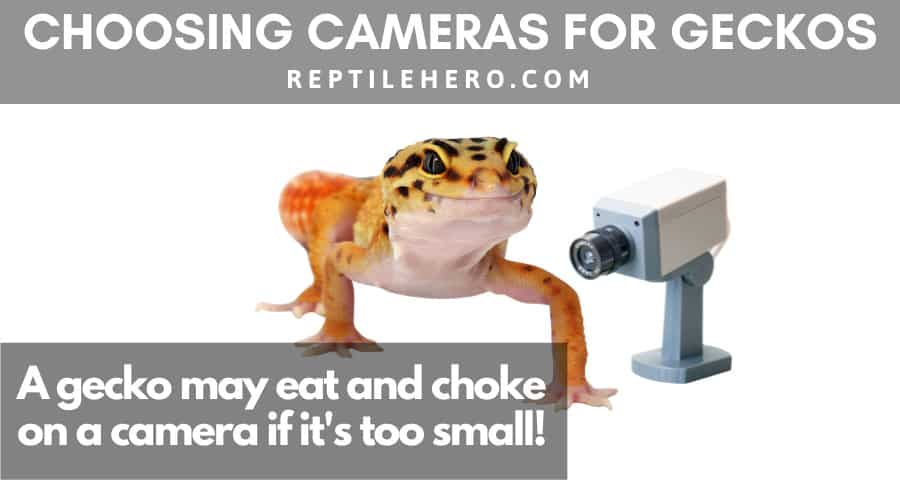
#2—Power Source
There are two main types of cameras that can be fitted in a gecko tank classified according to the power source: 1) battery-powered and 2) corded electric. Battery-powered cameras are easier to install in a tank due to the lack of a power cord.
Quite honestly, there is no major difference between battery-powered and corded electric cameras besides the fact that the latter needs to be plugged into a wall socket or power trip for it to operate uninterrupted.
The choice is basically based on the individual preferences of pet owners for this factor. Each type has pros and cons.
Some gecko parents like corded electric cameras like the one above are better because you will not need to worry about the battery draining prematurely and having to constantly remind themselves that they have to recharge it. Then again, these won’t work during a blackout unless you have a charged-up power bank at hand.
Other keepers prefer battery-powered cameras since these allow for less power consumption. Moreover, some models can be recharged using a small solar panel. There are also units that have replaceable batteries. But rechargeable cams typically double the price.
How long do battery-powered cameras work after one charge while monitoring a gecko tank?
Rechargeable battery-powered security cameras have a battery life of anywhere from 1 month to 3 years after a single charge depending on the power capacity of the battery. It’s also worth noting that camera functions that require more power for optimal operation will drain the battery quickly.
#3—Night Vision Capability
Night vision capabilities are now commonly found in modern security camera models. This feature is highly practical as it allows gecko owners to monitor geckos of different species and their varying natural activity times without being intrusive.
Although night vision capabilities aren’t necessary for cameras used to monitor diurnal geckos, night vision cameras are far more useful in that they can record videos and take pictures even in extremely low-light or pitch-black environments.
These cameras are perfect for checking on crepuscular and nocturnal geckos without disturbing them with bright lights and all the unnecessary noise we make while trying to get a good look at them directly from their tanks.
Cameras let us see into places with little to no light thanks to built-in infrared (IR) illuminators. Commonly, illuminators and image intensifiers are found in the form of LEDs or lasers emitting infrared wavelengths from 750 to 1100 nm—falling in the near-infrared (NIR or IR-A) range of the electromagnetic spectrum [1].
Illuminators with shorter wavelengths—around 800 nm—may have a very dim dark red glow to them when the camera is operated in complete darkness if you look directly at it.
Nowadays, you can even find night vision cameras that not only produce colored images during the day but at night as well using additional light-sensitive filters. Plus, the switch from day to night mode is done automatically depending on the available ambient light.
Will the infrared (IR) illuminator and indicators of a camera disrupt a gecko’s sleep-wake cycle?
Geckos can’t see infrared unless it is produced alongside a visibly bright light such as a halogen heat lamp. Illuminators and indicators in cameras are generally invisible or just barely visible. Their pupils only constrict if their eyes are directly in front of the indicators, otherwise, they stay dilated.
#4—Functionality
The main function of security cameras within the reptile-keeping community is to capture still images and film videos and clips of geckos in a non-invasive way.
However, I would say this is just the bare minimum in terms of overall camera functionality.
Considering how fast technological devices develop in a span of a few months, we can now make full use of numerous other functions to ensure the proper husbandry and well-being of our geckos.
Besides simply recording, some cameras also offer additional functionalities including 1) live streaming, 2) playback viewing, 3) time-lapsing, 4) automatic stamping, 5) motion detection, and 6) sound detection.
Additional Functionality #1—Live Streaming.
This allows owners to monitor and observe geckos continuously—or at certain times—in great detail on a live feed using a mobile phone or desktop computer application.
Additional Functionality #2—Playback Viewing
This enables busy keepers to review footage that they wouldn’t and/or couldn’t have been able to view in real-time.
Additional Functionality #3—Time-Lapsing
This setting gives the gecko parents the option to examine several hours’ worth of video in just a couple of minutes instead of scrubbing through the entire length of the video.
Additional Functionality #4—Automatic Stamping
This lets keepers and breeders take note of the exact dates and times of important biological events such as breeding and shedding.
Additional Functionality #5—Motion Detection
This makes it possible to conserve more power as geckos are not characteristically active animals throughout the day, only recording when they are on the move.
Additional Functionality #6—Sound Detection
This permits the recording of their calls and clicks which can help owners better differentiate between the different sounds they produce and what they mean.
Pro Tip: Keep in mind that the sensitivity of the sensors for motion and audio detection should be adjusted accordingly for it to properly trigger the camera to start recording and/or send off alerts for any abnormality.
This will save you a lot of time and concern from false alerts—believe me, I learned this the hard way.
#5—Connectivity
As a rule, connectivity in cameras for gecko tanks refers to the ability to access footage, control the device, and get notified remotely without having to be connected to the same internet connection. This can be particularly useful for gecko owners who are often not at home for several hours a day due to studies and/or work.
Security cameras can connect to the internet using two methods. Originally, cameras had to be directly connected to a landline or router via ethernet cables to gain internet access—hence the name wired security camera.
These days, however, wireless cameras are becoming more and more popular. Wireless security cams are directly connected to the internet through Wi-Fi networks—some also use cellular networks.
Either way, I recommend security cameras with internet connectivity because they typically offer much more functionality. This includes the ability to live stream high-definition video footage from your gecko tanks among other things.
More often than not, they also come with applications that are compatible with various devices that have different operating systems (e.g., Android, iOS). The user interface of such apps is normally pretty straightforward as well.
Getting promptly notified of weird sounds and movements in my gecko tank also gives me peace of mind because I can easily check on my gecko to ensure its safety. Friends and acquaintances with other pets such as cats and dogs share the same sentiments.
#6—Media Storage
When choosing a camera for a gecko tank, the memory storage is important. Security cameras store collected footage in either cloud storage, directly uploading media to an online server(s), or local storage such as internal and external devices. A few models also offer both, in which one will serve as a backup for the retention of gecko footage.
Personally, I prefer local storage as it is more secure compared to cloud storage. However, I would still need to connect to the internet if I want remote access to the pictures and videos or save certain clips onto my phone.
Of course, you could simply view the recordings on a computer or phone if you have a card reader with you whenever needed. Then you could simply copy the data onto your computer if you want to—no downloading necessary.
Unfortunately, security tech companies offer these cams with quite limited external storage capacity—usually no more than 128 GB—to promote their own cloud storage services.
Some companies offer a free cloud storage option with limited space, whereas others offer several cloud storage packages with bigger capacities and additional features that require monthly subscriptions.
Be Careful: I strongly advise you to read through their privacy and data policies to ensure that you’re not giving away information you don’t want to. Also, position your camera so that only your gecko and its enclosure can be viewed, giving away no important personal information.
As discussed earlier, you need a stable internet connection for uninterrupted recording and access to the camera wherever you are—on a vacation or driving your car to work. This also ensures that the footage gets uploaded into the cloud properly.
#7—Field of View
Fixed cameras offer good coverage inside gecko tanks, however, they often have blind spots. Pant-tilt-zoom cameras, on the other hand, can provide total coverage in larger spaces such as reptile rooms.
Cameras offer a field of view (FOV) ranging from approximately 50º to 360º horizontally.
Fixed cameras only cover a single and often narrow field of view—90º will be more than sufficient for medium and large enclosures. Unless you move the unit itself, the camera will not change its focus, often having multiple areas out of coverage.
Though only offering restricted camera coverage, with smart placement in your gecko’s tank—often in one corner—fixed cameras will be more than enough for regular monitoring.
In comparison, pan-tilt-zoom (PTZ) cameras, like this one on Amazon, have a greater field of view as they are often also able to swivel both vertically and horizontally.
These units may either automatically swivel the more affordable camera and scan the area or be programmed to change its field of view according to a preset time frame. Such movement may produce audible noise that could surprise and puzzle your geckos.
So if you have a room with a large collection of geckos among other exotic animals but you don’t have the budget to install one camera in each tank, a single pan-tilt-zoom cam will allow you to get a good view into each tank without having to shell out hundreds or thousands of bucks.
#8—Picture Quality
A minimum resolution of 720p (720×1080) with great photosensitivity, high contrast, and low distortion is recommended for pet owners so that they can efficiently observe geckos in their tanks regardless of whether it is day or night.
High resolution allows for clear images even when zooming in a couple of times to focus on a certain area or object within the vivarium—the loss of details will be negligible.
Due to the constant advancement in technology during our time, 720p, although already high definition (HD), is frankly considered inadequate by many pet keepers in terms of image quality. Owing to the fact that there are even security cameras that offer an extremely high picture quality and resolution of 4K (3840×2160), also referred to as ultra-high-definition or UHD, this is not surprising.
However, unless you’re planning to create some sort of documentary or movie using all the footage you get out of recording your pet geckos with a camera, I would say that such high resolution is not at all necessary.
Aside from resolution, the following facets are also important in determining a camera’s overall picture quality:
- Photosensitivity. This refers to a camera’s ability to produce details and crisp images even in conditions with substantially low light. Ideally, the camera should have photosensitivity not only in the visible light region for daytime but also in the near-infrared (NIR) spectrum for nighttime.
- Contrast. Whether day or night, colored or monochrome, this quality makes it possible to differentiate between objects easily. During the night, this is especially important for distinguishing between similarly colored objects within the gecko tank.
- Distortion. Grainy, pixelated, and warped images are some of the common distortions or noise familiar to most people. Needless to say, these are all undesirable so look for cameras that produce low visual distortions.
Take all of these into account as good resolution alone won’t be sufficient in producing images and videos or high clarity and great quality.
#9—Waterproof Rating
In general, for usage in a gecko tank, cameras don’t need to be water-tight. Nevertheless, whether it is resistant to water or not will determine if it can be safely mounted inside a humid tank environment or not. If the camera can handle neither water nor moisture, external mounting is the only option.
Catchy terms such as “water-resistant” and “waterproof” are commonly used by a lot of companies for marketing purposes. But don’t just take their word for it, especially if they never specify their product’s ingress protection (IP) rating.
Ordinarily, IP codes are formed by 4 characters. The first two characters are the letters I and P which are abbreviations for the term ingress protection. A set of two numerical codes follow this, indicating the device’s degree of ingress protection against solid foreign objects and water, in that order.
Below is the table of numerical codes for ingress protection from solid matter and water [2, 3].
| Numerical Code | Description of Solid Object Ingress Protection | Description of Water Ingress Protection |
| X | No available data | No available data |
| 0 | None | None |
| 1 | Items larger than 50 mm (e.g., hand) | Dripping (from above) |
| 2 | Items larger than 12.5 mm (e.g., finger) | Dripping (at an angle of up to 15°; to the sides) |
| 3 | Items larger than 2.5 mm (e.g., screwdriver, thick wires) | Spraying (at an angle of up to 60°; to the sides) |
| 4 | Items larger than 1 mm (e.g., thin wires, ants) | Splashing (any direction) |
| 5 | Dust-protected | Low-pressure jets (6.3 mm nozzle; any direction) |
| 6 | Dust-tight | High-pressure jets (12.5 mm nozzle; any direction) |
| 7 | — | Temporary immersion; depth of up to 1 m (3 ft 3 in) |
| 8 | — | Continuous immersion; depth of 1 m (3 ft 3 in) or more |
| 9 | — | High-pressure and high-temperature water jets (any direction) |
Even if a camera is rated IP68 you can’t just plop that into a water feature in your gecko’s tank, leave it, forget it, then expect it to keep working. In reality, testing conditions for setting a device’s IP ratings generally last between 30 minutes to a couple of hours. But regularly misting that camera in a gecko vivarium won’t destroy it.
Additionally, the code may have a fifth additional letter and a sixth supplementary letter indicating specific protection of personnel and equipment (e.g., B for finger and W for weather conditions, respectively).
Pro Tip: Outdoor cameras normally undergo testing to determine their IP rating, this can be safely mounted inside an enclosure. Conversely, indoor cameras are not usually tested so it is safer to place them outside your gecko’s tank.
#10—Resistance to Heat
Gecko tanks should be fitted with cameras that have a minimum operating temperature of 40ºF (4ºC) and a maximum operating temperature of 120ºF (49ºC). This is well outside the average thermal needs of most gecko species to account for unusual weather events and malfunctioning of heating and/or cooling equipment.
Some security cameras can withstand temperatures extreme of -40–167ºF (-40–75ºC). Because most gecko species don’t normally experience such temperature extremes in their native habitats, getting such cameras would be overdoing it.
These heat and cold resistant cameras are conventionally a lot bulkier—with internal cooling and heating mechanisms—and much more expensive. They could cost up to several thousand dollars per unit.
Keep in mind, however, that cameras should never be left to operate in either extreme for prolonged periods. Though it could continue working after, the camera may no longer be able to operate efficiently even if it didn’t sustain physical damage [4].
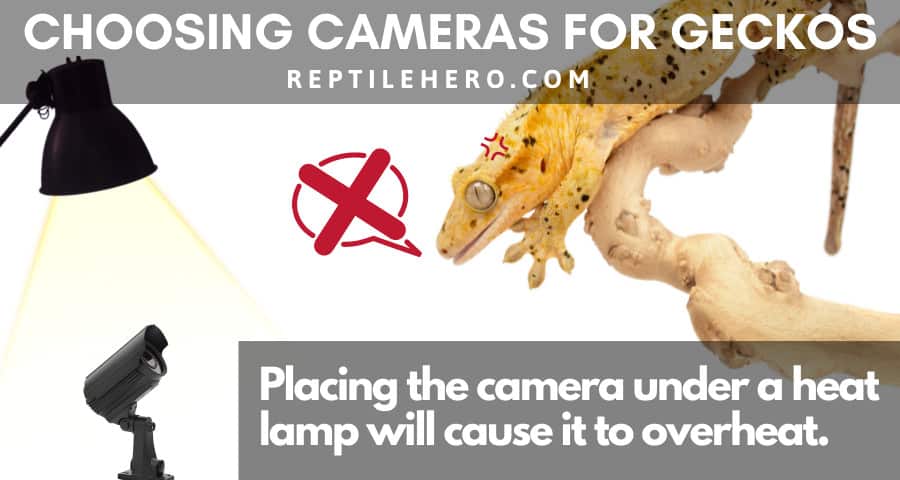
Pro Tip: Don’t place your cameras right underneath heating elements such as halogens and carbon projectors. This may cause your camera to overheat and malfunction—which could potentially start a fire and kill your gecko.
Further Questions
Does the small dot(s) of light from security cameras stress out geckos?
For the most part, geckos don’t get stressed out by the LED indicators and infrared illuminators in security cameras. It doesn’t greatly disturb their normal daily activities either. But if you are still worried about it, most updated models provide gecko owners with the option of turning off the lights.
Will geckos notice the camera if it is placed inside their tank?
Yes, most geckos will easily and quickly notice if a camera is placed inside their tank because of the light and sound produced by it. This is because geckos have a great sense of hearing and seeing even in really dark spaces.
How many cameras can pet owners install inside a gecko tank?
The total number of cameras a gecko owner can place inside the gecko tank depends primarily on the size of the tank. For most small and medium-sized tanks (20 to 50-gallon vivariums), one camera with a generous field of view would suffice.
What is the price range of night vision cameras which can be used for gecko tanks?
A single good quality security camera for your gecko tank that has night vision capabilities can cost anywhere between 20 USD to 200 USD. This estimation does not include the monthly cloud service subscriptions offered by most manufacturers.
Can you use weatherproof cameras inside gecko tanks?
A weatherproof camera is generally highly resistant to temperature extremes and has a sturdy housing that protects its internal components from the ingress of foreign objects and water. Thus, it is ideal for internal mounting for gecko tanks.
Takeaways
Compact cameras are preferable for both internal and external installation in gecko tanks.
Though corded cameras require a continuous power source, they are preferred by many gecko owners as they don’t require regular recharging.
Opt for cameras with night vision capability for gecko keeping and breeding.
Gecko owners should look for cameras that offer the functionality of video recording and picture taking, as well as live streaming, playback viewing, time-lapse recording, automatic date-and-time stamping, motion-triggered recording, as well as sound-triggered recording.
A wireless security camera in a gecko tank is practical as it permits gecko owners to remotely access the camera feed, control the device, and get notifications.
In terms of media storage, it is advisable that gecko keepers and breeders choose security cameras that offer both local and cloud storage.
The camera for geckos tanks should ideally be pan-tilt-zoom types as these have a much wider and controllable field of view.
Gecko tank cameras should have a high-definition (HD) resolution, high photosensitivity, and good contrast, but minimal distortion for good overall picture quality.
Only cameras specified for outdoor usage and with ingress protection (IP) ratings are recommended for mounting inside gecko tanks.
The operating temperature range of gecko tank cameras should fall within 40–120ºF (4–49ºC) to account for the thermal needs of most species and other factors such as extreme weather, and equipment malfunction.
Sources
[2] https://www.iec.ch/ip-ratings
[3] https://www.gwp.co.uk/guides/ip-ratings-explained/
[4] https://www.sciencedirect.com/topics/engineering/operating-temperature-range

